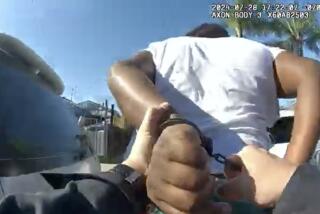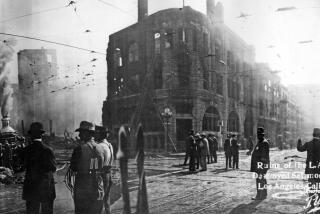Easy Rawlins inside the raging mind of Watts
Nearly 40 years later, the Watts riots still come at us like a bad dream: A young, easygoing, slightly inebriated black man is stopped by a Highway Patrol officer at the corner of Avalon and 116th streets. It’s a hot summer evening. A crowd gathers, and within 24 hours Los Angeles is fighting a race riot. Buildings burn; stores are looted. Watts is under siege; soon, 13,000 National Guardsmen are in the streets. Within six days, 34 people are dead.
In his continuing portrait of black and white life in this city, Walter Mosley has dipped his pen into the nightmare of that summer evening and come up with his most searing and unforgettable account of America to date. Indignation, ferocity, excoriation scorch the pages of “Little Scarlet” like a fiery sermon, powerful for its nuance, poignant for its humanity and all the more compassionate for coming from the heart and mind of Easy Rawlins.
“The morning air still smelled of smoke.” Rawlins gazes out of the fourth-floor window of his office on Central Avenue. It’s Aug. 18, 1965, seven days after that fateful traffic stop, and Rawlins is in a state of shock. His neighborhood looks “like Germany did when we marched in at the end of the war. And it was like a war,” he considers. “A war being fought under the skin of America.”
He still lives in West Los Angeles with his girlfriend, his adopted family and that little yellow dog. He still works as a custodian at a junior high school and moonlights -- “research and delivery,” as he describes his investigations -- in South-Central. Just 10 months earlier, he was asked to track down a young man who had gotten tangled up with a black radical group. Vietnam and the civil rights movement boiled in the background, and by the end of “Bad Boy Brawly Brown,” a fuse of frustration and rage had been set and lit. Less than a year later, it hit the powder keg.
You could say that the Watts riots were the result of events that Mosley depicted in his first novel of 1940s Los Angeles, “Devil in a Blue Dress.” You could say that the generation that came of age 15 years later was less abiding and patient than the previous one. You could say that Mosley needed time -- and 18 other books (eight in this series alone) -- to develop the character of Rawlins and splice the threads of this city together.
But no single explanation -- not the history itself or Mosley’s talent -- can account for the sheer power of this story. As Flaubert tapped into the chaotic energies of 1848 Paris to write his masterpiece “Sentimental Education,” Mosley has found his own narrative charge in the streets of South-Central. As James Ellroy defined the landscape of 1950s Los Angeles in “L.A. Confidential,” Mosley has created an indispensable picture of the city in the ‘60s. The real achievement of “Little Scarlet” is a parallel narrative to the riots’ aftermath that provides a more personal drama, holds the action to the end and informs and explains the powder keg itself.
Nola Payne -- or Little Scarlet, as she is known, for the reddish tint of her hair -- is a black body on a silver table, surrounded by three white men in smocks. A trickle of blood from her mouth has dried across her cheek, “as if she died with her lips whispering vermilion secrets.” And she is a huge liability.
Earlier that day, Payne’s aunt had discovered her body strangled and shot in Nola’s third-floor apartment on Grape Street. She called the police, screaming that a white man had killed her niece. It’s a plausible story and bad news for the police, nothing less than gasoline on the cooling embers of the riot. They whisk the aunt away and strong-arm Rawlins into the investigation. “[Y]ou’re down there playing like you’re a private detective when you don’t have a license,” he’s told. “That could pull down jail time if somebody wanted to prosecute.”
Working with a white detective in a rumpled green suit, Rawlins discovers a trail of blood that leads to at least 20 other murders, callously investigated. In facing such cold indifference by the police to the people who live in Watts, Rawlins unreels in his mind the prospect of “a whole factory of death working twenty-four hours a day under the city. Black people being thrown down onto rolling spikes that chopped them into pieces and then dropped the pieces into vats of acid. Maybe they were selling our blood and using our teeth and bones for ivory.”
Mosley has not so much written the story of “Little Scarlet” as detonated it. But before you dismiss the novel as all polemic and fury, realize that Mosley is too accomplished a writer to follow that route. He knows that it’s not the action you see but what you can catch out of the corner of your eye that sometimes matters most.
Whether it’s a jelly doughnut at Trini’s (without “so much sugar that the lemon lost its tang”), a description of Los Angeles (“Even the poorest streets had houses with lawns and running water to keep the grasses green....”), an informant’s apartment (with “six crates of new dishes, three model train box sets, and a dozen or more pairs of green work pants”) or the plight of people too afraid to step outside, Mosley humanizes an often-overlooked part of this city.
He also throws in a few set pieces -- the reluctant dick and drugged P.I. (in both cases, Rawlins), moody pictures of the city itself, the femme fatale -- and he takes us through some familiar territory. We run into Paris Minton (from “Fearless Jones” and “Fear Itself”), whose Florence Avenue Bookshop is protected by a sign reading “SOUL BROTHER,” and Mama Jo (“Gone Fishin’ ”), the healer who can raise the dead. Most surprisingly, we discover what became of Mouse, Easy’s longtime running companion, last seen in “A Little Yellow Dog.”
Easy’s chief confederate in “Little Scarlet” is Melvin Suggs, that cop in the rumpled suit whose sense of decency toward Easy in the course of the investigation is a little unnerving and only emphasizes how much the riots have changed the landscape of the city. The closer they get to discovering who murdered Little Scarlet, the closer we come to understanding the rage inside the mind of Watts.
“If everybody in the world despises you and hates you, sees your features as ugly and simian, makes jokes about your ways of talking, calls you stupid and beneath contempt; if you have no history, no heroes, and no future where a hero might lead, then you might begin to hate yourself.... And then one hot summer’s night you just erupt and go burning and shooting and nobody seems to know why.”
But to say that the riots were caused by a long history of racism and police brutality raises a more difficult question: What did they accomplish? After Rawlins is set upon and nearly killed by another black man in a back alley, he thinks of the riots as a random mugging and worse: a case of black-on-black violence.
The riots were no different than that attack, he realizes. “There was no real winner. Fear on one side, defeat on the other.” As easily as Rawlins wonders about himself and his chances for a better future, Mosley carefully draws out the lingering psychological effect of racism.
“Pain has a memory of its own,” Rawlins says early on, and by the conclusion of “Little Scarlet” it becomes clear that the pain and memory of racism have been passed down, generation to generation, like a disease or a bad mutation. How society sees us determines how we see ourselves and -- most poignantly -- how we see our children. The Watts riots may have taken place on the streets of Los Angeles, but they also occurred every day, consciously or unconsciously, inside the psyches of its black residents.
In the spring of 1966, Thomas Pynchon visited Watts to follow up on the recent shooting by a white policeman of a black man during a traffic stop -- and to ask where Watts was nearly one year after the riots. “Far from a sickness,” he subsequently wrote, “violence may be an attempt to communicate, or to be who you really are.”
“Little Scarlet” is a novel about who we really are and who we all can become. Argue it. Question it. You cannot read this story without recognizing the poison we feed one another. Mosley makes it clear that the real nightmare of the Watts riots had less to do with that hot summer evening in 1965 than with everything that preceded it. *
More to Read
Sign up for our Book Club newsletter
Get the latest news, events and more from the Los Angeles Times Book Club, and help us get L.A. reading and talking.
You may occasionally receive promotional content from the Los Angeles Times.









